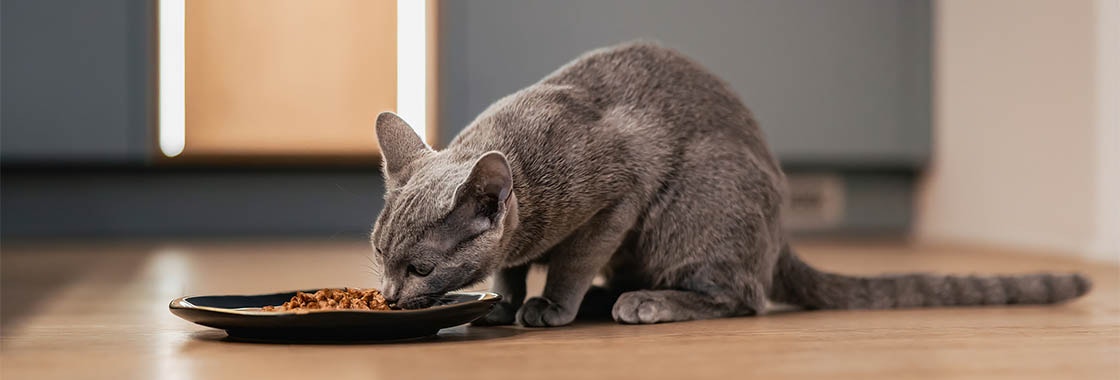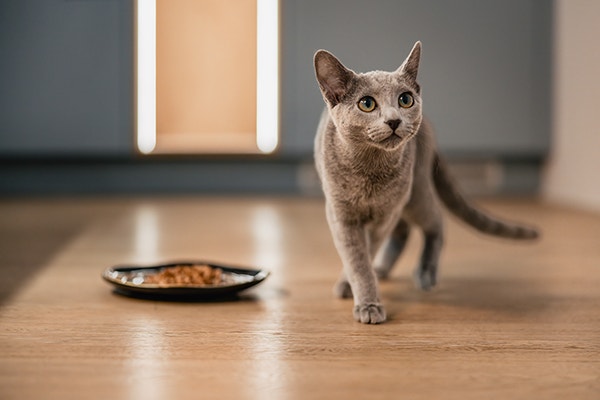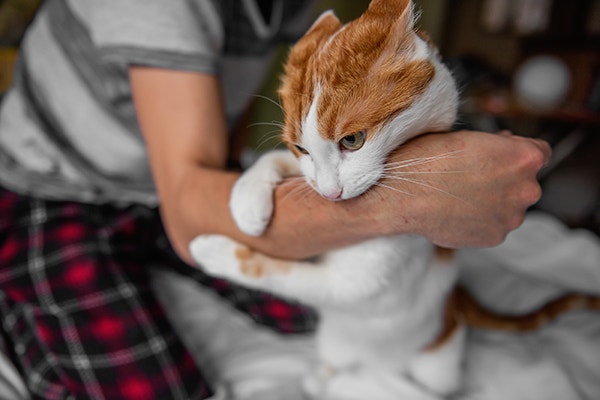Fussy cat food: A guide to feeding picky cats


Share
Why is my cat so picky about wet food? Having a fussy cat with food issues is a common conundrum for many owners, cats also tend to be particularly finicky about wet food. Just like humans, cats have certain food preferences, with some preferring specific food types and textures over others. This fussiness can be behavioural in nature, however, it may also indicate underlying health issues, such as dental problems, so understanding why your cat is not eating certain foods is important. In this article, we will explore this issue in depth so you can figure out why your cat is being picky and what the best cat food for fussy cats in the UK is!
Why is my cat so picky about food and what is deemed normal?
There is a difference between food fussiness and underlying health problems that may be contributing to cats avoiding certain foods. In this section, we will explore these issues in detail to help empower you to spot potential health red flags when they arise or find the right food for fussy cats.
Is my cat actually a fussy eater or are their food habits normal? In the wild, cats would naturally eat several small meals a day, in line with their hunting capability. Most domesticated cats will still instinctively feed this way, so it is considered normal for a cat to consume a small amount and walk away.
A good, healthy feeding routine for a cat is to offer wet food twice a day, once in the morning and once in the evening. You should also make sure they have access to a supply of dry food to graze on as and when they choose throughout the day.
Always serve quantities/portions in line with the feeding guide on pack and ensure that the food you offer is complete and balanced, containing all of the nutrients your cat needs for its life-stage and life-style.
Puzzle feeders are an interactive way to serve some of their dry kibble and ensure they don’t eat it too fast. Essentially your cat plays with a toy which dispenses treats as it moves around, providing both physical and mental stimulation during mealtimes.
Common causes for fussy eating in cats
The most common causes for food fussiness in cats stem from behavioural issues and environmental causes. Behavioural causes for a fussy cat with food issues include poor food routines, stress levels affecting their appetite, and certain preferences for food temperature or texture not being fulfilled. Environmental factors which can make a cat fussy with food include problems with food bowl hygiene, hot weather affecting their appetite and the stress of multi-cat households.
Irregular schedule
Cats thrive on routine, and irregular feeding schedules can have a huge impact on their overall appetite and motivation to eat their food. Always aim to feed your cat at the same time every day if this is an issue in your household!
Texture and flavour preferences
It's important to remember that cats are individuals with their own unique food tastes and preferences! For example, some cats prefer the texture of pate, others love wet food that comes in rich gravy chunks, and some will always favour crunchy dry food. Texture can be just as important as food type or taste to cats. At Sheba, we understand that finding the best cat food for fussy cats can be stressful for owners. This is why we offer a diverse range of food types and textures to appeal to every feline's unique taste buds.
Stress, anxiety, or environment
Sometimes a lack of privacy, issues with food bowl location or stressors in their overall environment may be a contributing factor fuelling your cat's food fussiness. Cats like to hide their food from other animals, so ensuring they have privacy to chow down, especially in multi-cat households, is important. Bowl location is also a big factor, as cats do not like eating close to their litter box, which is understandable; we don’t eat in the bathroom either! They also prefer to eat in an area that is separate from their water bowl. This is because cats instinctively don’t want food particles contaminating their main water source.
Excess of options
Humans like to believe that variety is the spice of life, but this is less true for cats! If they are being fussy with cat food when you have been rotating the flavour or type, offering too many options could be the cause of their food finickiness. Feeding your cat an abundance of human food, like tuna or chicken and treats can also spoil their appetite for their usual cat food and result in them snubbing their main meals.
Food quality and freshness
Always consider the quality and freshness of the food you are serving your cat, cats generally avoid stale kibble, and wet food will go off more quickly, too, especially in the heat. Cats also dislike very cold wet food, so avoid putting it in the fridge, and serve unopened pouches at room temperature. Sheba’s Fresh & Fine range is perfect cat food for fussy cats, utilising smaller packs for further freshness!
What’s the best cat food for fussy cats?
It can be stressful trying to figure out what is the best cat food for fussy cats available in the UK, below we will compare and contrast different food types and their pros and cons to make your decision a little bit easier! All cats have their own unique preferences, but with some observation combined with trial and error, you can crack their culinary code.
Wet food for fussy cats
Why are cats so picky about wet food?! Wet food notoriously divides some cats, despite it being considered somewhat better for the cat's overall health due to its higher water content. Owners often find their cats licking all the jelly or gravy off and leaving the meat, which can be frustrating and wasteful. If this is the case, you may want to try them with pate products instead, or try mashing the chunks into the jelly/gravy. You can also try warming the sealed pouches to room temperature; this enhances the smell and may make the wet food more appealing. However, some cats may always maintain a preference for dry food.
Dry food for fussy cats
Dry food/kibble could be the best food for fussy cats, especially if you have explored all of our suggestions to make wet food more palatable, and they are still snubbing it. Dry food is considered more convenient overall as it is cheaper and doesn’t go off as quickly. The abrasive texture is also good for your cat’s teeth. Some cats may find kibble less appealing as it isn’t as aromatic as wet food, and it is dehydrated, however, it is generally highly palatable and well tolerated, especially with cats who are picky about wet food.
How to encourage a fussy cat to eat
It’s important to keep in mind that changing your cat’s diet suddenly can also cause them to snub food, as they thrive with routine. So before rushing to change and experiment with new food, make sure you’ve got all the bases covered. If you do decide to experiment with different flavours or textures of food, make these changes gradually over time, mixing a small amount of the new food with old food to avoid stomach upset. And if you’re giving them wet food, ensure to check how much wet food you need to feed a cat.
- Keep a regular feeding routine and maintain similar portions.
- Make sure food bowls are cleaned regularly
- Ensure food bowls are placed far away from the litter tray in a private, quiet area
- Address potential stressors in the home environment
- Adjust food temperature and presentation
- Avoid rotating flavours or giving them human food/treats right before mealtime
- Ensure food is fresh
When is fussy eating a health concern?
Occasionally your cat’s fussy eating is in fact a cause for concern, especially if you have tried our previous tips to no avail. Red flags to be vigilant for include cats not eating for over 24 hours, rapid weight loss, signs of dental pain such as pawing at the mouth and bad breath or vomiting and diarrhoea. You should always visit your vet for a check-up as soon as possible if you notice these accompanying symptoms. Hepatic lipidosis can be a risk for cats that stop eating very suddenly, especially if they are overweight. Hepatic lipidosis is a serious and severe condition that affects the liver and can result in liver failure, so always act quickly if your cat stops eating altogether.
FAQs about feeding fussy cats
What do I feed a fussy cat?
It can be stressful feeding a fussy cat, but it is also a common problem, especially with wet food, as many cats will lick at the gravy or jelly and leave the chunks. If this is an issue, you could try mashing the chunks into the jelly or feeding them a terrine formula. Experimenting with different flavours and textures may help. At Sheba, we have a huge range of delectable wet cat foods to appeal to even the fussiest of cats!
Why is my cat being so fussy with food?
Cats being picky with their food is a common problem owners face, it usually stems from behavioural causes, such as a lack of routine with feeding times or food texture preferences. It could be an environmental issue, such as bowl cleanliness and placement, or hot weather. In rare cases, it may also signal underlying health issues, so getting to the bottom of their fussiness is key.
Are dry foods bad for fussy cats?
No, dry food is not bad for fussy cats. All cats have their own unique tastes and preferences, and some will always prefer kibble. It is also very convenient and cost-effective, choosing a high-quality dry food is key, as well as ensuring your cat is well hydrated. It is a good idea to utilise a water fountain if they are on a dry food only diet.
Why won't my cat eat their food but will eat treats?
Many cats are fussy eaters. Your cat may just have a preference for treats, and this is spoiling their appetite, try to avoid feeding them any before mealtimes. Environmental factors (bowl hygiene, multi-cat households, hot weather), or behavioural factors (routine, stress, food temperature, texture preferences) could be at play.



